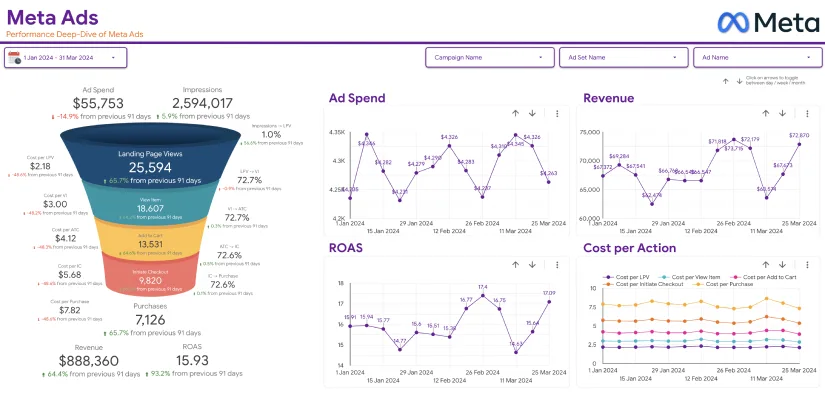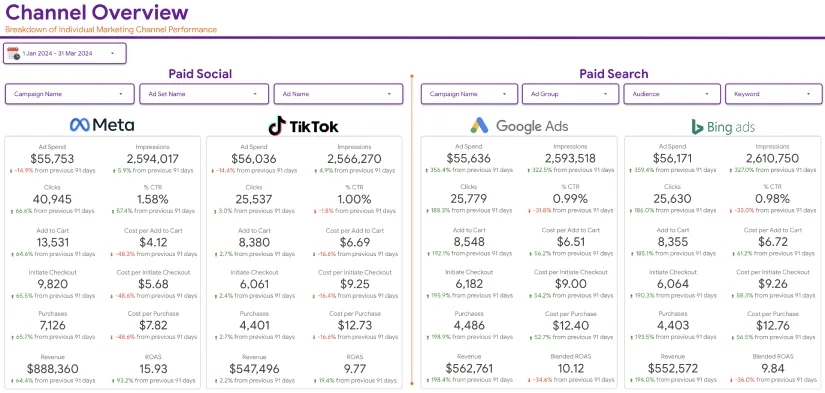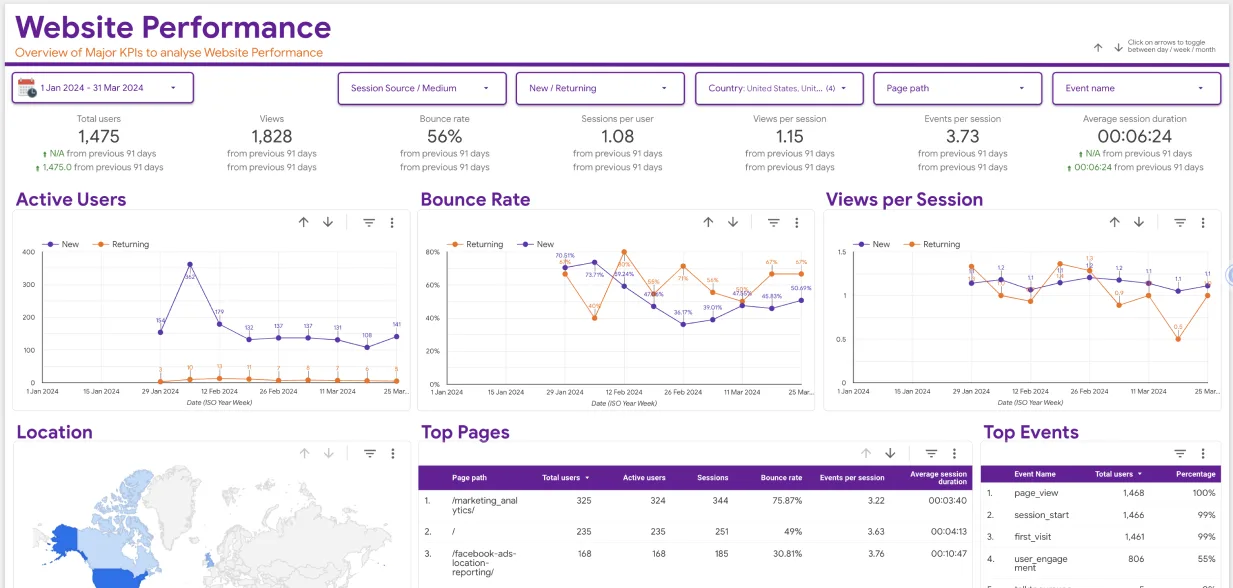Product vs marketing analytics is a topic you will frequently encounter if you operate an online business. The term “analytics” is broad and has applications in many different business and marketing environments. It boils down to gathering essential information to understand the customer’s journey and using that information to streamline the procedure.
It’s common to confuse the many applications of marketing and product analytics. They may have superficially similar criteria and are connected. However, what does product and marketing analytics entail? And what distinguishes them from one another? This article will explore each analytics more, looking at their distinctive features.
What is Google Analytics?
Google Analytics provides insightful information to assist brands in evaluating the success of their marketing campaigns through its customizable reports and goal-setting tools. This facilitates the optimization of marketing initiatives and leads to data-driven decisions. Through Google Analytics, you can find areas where visitors to your website are coming from. To deploy resources efficiently, you can assess which channels bring in the most traffic and conversions. Google Analytics is one tool that businesses shouldn’t neglect or take for granted.
What is Product Analytics?
Product analytics focuses on gathering information about the customer’s experience after purchasing. The first step entails gathering information on user trends, bounces, friction points, most and least popular features, and other aspects of how customers use and interact with a product.
After that, a data analyst crunches the information to find the product’s advantages and disadvantages so that it can eventually be improved to improve the user experience. For example, trends analysis assists product teams in determining which features are most and least used so they can compare recent data to historical data to identify broad trends that have developed over time.
Additionally, product analysis assists product teams in determining which touchpoints are most influential so they can concentrate their future efforts there to optimize revenue.
Importance of Product Analytics

Product analytics has always involved a certain amount of luck. Regardless of how often you inquire about a customer’s preferences, dislikes, and things they can’t stand, there’s always a chance they’ll do something completely unexpected. Let’s explore some product analytics benefits before looking at product vs marketing analytics differences.
Provide direction for product design and development
Product analytics aids in the place of product design. It is simpler to understand what clients use and don’t utilize, thanks to the amount of knowledge provided by recording user events. By eliminating features that are not in use and keeping the most useful ones, you can make your product lighter, faster, and leaner.
Product analysis also helps provide hard data without any emotional bias attached. Spending money on advertising that you think would be successful is not required. Rather, apply your data to improve consumer experiences and direct people to the goods you are confident will do well.
Results in better relationships with customers
Companies gather consumer information to improve their online experience when buying their products or goods. Through product analytics, organizations can leverage this data to generate user profiles, which provide more tailored experiences and insights into customer behavior. It optimizes every step of the customer’s journey by applying behavioral analytics to customer segmentation.
Mitigate danger and address friction
Product analytics assist companies in identifying hazards and implementing countermeasures. A SaaS solution might use statistical modeling to forecast future behavior or occurrences and identify which features are most likely to be abandoned. With this information, the product team can decide how much marketing is necessary or whether to switch to a different feature set.
What is Marketing Analytics?
After delving deeply into product analytics and its importance in improving the user experience, let’s look at marketing analytics and its critical role in developing company strategies and successfully interacting with customers. Though it has different goals and resources, marketing analytics is just as powerful as its counterpart.
Marketing analytics deals on understanding and optimizing prospects’ and customers’ journeys from initial awareness to final purchase and beyond. It analyzes how well marketing campaigns perform across a range of media to maximize return on investment (ROI) and improve targeting techniques.
Importance of Marketing Analytics

Marketing analytics is essential for firms to succeed overall, make wise decisions, and maximize their marketing budgets. Let’s examine the benefits that marketing analytics can offer your company.
Understanding consumer behavior
You can plan by tracking consumer behavior and seeing what they are doing with marketing analytics. Before deciding what to buy, every customer has a distinct experience. Through marketing analytics, companies can acquire a significant understanding of how consumers engage with their brand on multiple channels, including social media and search. These insights drive growth and cultivate client loyalty by enabling marketers to offer customized experiences and personalized information at every point of the customer journey.
Enhancing brand awareness
Brand recognition is essential to attracting clients in today’s competitive industry. Thanks to marketing analytics, businesses may examine important indicators across social media platforms and assess how well their brand is known compared to rivals.
Marketers can create strategies to increase brand awareness and obtain a competitive edge by analyzing search volumes, site traffic, and social media sentiment. Businesses may also use marketing analytics to monitor the effectiveness of their brands and make data-driven decisions to improve customer perception and brand visibility.
Making informed decisions
You can make decisions with the knowledge to support them. Furthermore, marketing has so many moving parts that it is easier to determine what is effective with a benchmark.
Marketing analytics can help you obtain data that facilitates more informed decision-making regarding your marketing strategy. With it, you could make decisions solely based on personal taste or gut feeling, which are only sometimes reliable sources of information!
Marketing Analytics Tools
Software applications known as marketing analytics solutions aid in collecting and analyzing campaign data for marketers and business owners. They track campaign performance to give you an idea of the return on investment you receive. The best tools for marketing analytics are listed below.
Heap Analytics

Heap Analytics is a tool that allows you to observe how users engage with your website and gain insight into their behavior. Using this data, you can decide on your marketing approach with data, not guesswork or assumptions, but based on user behavior.
Semrush
Semrush is a marketing analytics tool that provides information on the activities of your rivals. SEMrush gives you a competitive advantage in search results and makes monitoring competitors’ social media accounts and brand activity simple.
Google Analytics
One of the most popular and effective tools for marketing analytics is Google Analytics. It offers data on the quantity of visitors to your website, their activities while on it, and ways to enhance your website to increase conversions.
Product vs Marketing Analytics – Understanding the Key Differences
Product analytics vs marketing analytics take different approaches to this challenge, even though they both use data to drive corporate growth. Here are three main areas where they differ in further detail:
Metrics
Product analysts are interested in metrics like feature usage—the features users use most and those that are becoming stale—churn rate—the percentage of users who stop using the product—and feature adoption rates—the rate at which users take to new features—and session length, which is the time users spend using the app or product.
Market analysts, on the other hand, are tasked with understanding and improving business success through data such as click-through rates (the proportion of users who follow links or advertisements), cost per lead (the amount of money needed to draw in a potential customer), and website traffic (the total number of users who visit the website). However, it’s the conversion rates (the percentage of users who finish a desired action, such as completing a form or making a purchase) that truly measure the impact of their decisions on business success.
Goal or objective

The primary goal of product analytics is to improve the product to its greatest potential. By thoroughly understanding how consumers engage with the product, product teams may make well-informed decisions regarding design modifications, feature additions, and other aspects that influence the user experience.
However, marketing analytics aims to place the correct product in front of the right people and persuade them to take a chance. It all comes down to figuring out the best ways to connect with your target market, knowing what messages work the best, and eventually generating conversions.
Data Source
Product analytics is the lifeblood of the data produced by your product. It closely monitors how users navigate your application, use features—or don’t use them—and, in short, how they experience the things you’ve created.
Conversely, marketing analytics expands its scope by obtaining information from various sources. Marketers may monitor user reactions to advertisements on various platforms, website usage patterns, and social media activity.
Conclusion
Product vs marketing analytics both gather data and address the customer purchase journey. Effective marketing draws in clients. However, if the offering is convincing, you will retain clients again. It’s critical to comprehend how each sort of analytics functions because it facilitates data collection at every turn, enabling you to convert more leads into consumers and keep them around longer.






